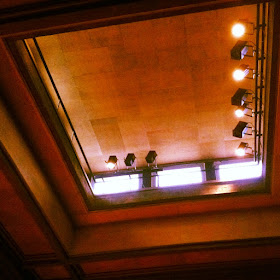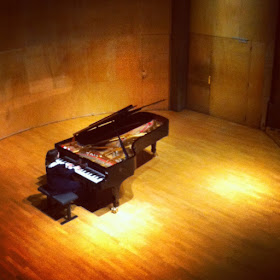
Auguste Perret's Salle Cortot offers a blank exterior to passers by, but its interesting interior can be experienced for free during lunchtime concerts on Tuesdays, Wednesdays and Thursdays!
The Salle Cortot on the Rue Cardinet in the 17th arrondissement is the concert hall of the École normale de musique de Paris, an institution that was created in 1919 by the pianist Alfred Cortot.
This particular date is not insignificant. Coming just after the end of the First World War, Cortot's declared intention was that his school would teach French music to international students, with the hope that this would limit the spread of Germanic influences.
Although the school began in 1919, it wasn't for another 10 years that it would get its own dedicated concert space. The first step towards this was the school's move to its present location, a 19th century Hôtel Particulier on the corner of the Rue Cardinet and the Boulevard Malesherbes. Behind this building were the stables of the house, which were demolished in order to make way for Cortot's concert hall.
The plot was an awkward size for a concert venue, measuring just 29 x 9 metres. This though was the kind of challenge that the venue's chosen architect, Auguste Perret, appreciated.
Step inside the venue today and you'll see that almost the entire space is taken up by the concert hall. The entrance area is cramped underneath the seating area which curves upwards overhead, and there are no ornamental staircases or champagne bars here. This is a serious, frills-free building, carefully designed to offer the best possible listening experience for music lovers.
If the exterior of the building adhers to the International Style doctrine that 'ornament is a crime' (the building's lack of decoration and its block form surely explain its nickname - 'l'armoire' (the wardrobe)), the interior of the hall is far more intimate and cosy.
This particular date is not insignificant. Coming just after the end of the First World War, Cortot's declared intention was that his school would teach French music to international students, with the hope that this would limit the spread of Germanic influences.
Although the school began in 1919, it wasn't for another 10 years that it would get its own dedicated concert space. The first step towards this was the school's move to its present location, a 19th century Hôtel Particulier on the corner of the Rue Cardinet and the Boulevard Malesherbes. Behind this building were the stables of the house, which were demolished in order to make way for Cortot's concert hall.
The plot was an awkward size for a concert venue, measuring just 29 x 9 metres. This though was the kind of challenge that the venue's chosen architect, Auguste Perret, appreciated.
Step inside the venue today and you'll see that almost the entire space is taken up by the concert hall. The entrance area is cramped underneath the seating area which curves upwards overhead, and there are no ornamental staircases or champagne bars here. This is a serious, frills-free building, carefully designed to offer the best possible listening experience for music lovers.
If the exterior of the building adhers to the International Style doctrine that 'ornament is a crime' (the building's lack of decoration and its block form surely explain its nickname - 'l'armoire' (the wardrobe)), the interior of the hall is far more intimate and cosy.
When presenting his designs, Perret promised Cortot that the building would 'ring like a violin'. Despite working purely with concrete, Perret was in spirit a classicist, and he wanted to prove that a natural approach towards costruction would be more effective than a scientific one. The nearby Salle Pleyel had recently been built, with the interior design being decided by an acoustic engineer. After listening to a group of pilgrims singing under a tree canopy, Perret thought he could do better by imitating the natural environment.
 The Salle is designed like the sound box of a musical instrument, with grooves carved into its concrete structure which are filled with thin strips of wood and air gaps. Perhaps just as importantly though, the concert stage is in the middle of one of the longer sides of the building, with the 400 or so seats spread around this. With no seat being more than 17m away from the stage, the bodies of the audience absorb acoustic vibrations, thus reducing echoing inside the venue.
The Salle is designed like the sound box of a musical instrument, with grooves carved into its concrete structure which are filled with thin strips of wood and air gaps. Perhaps just as importantly though, the concert stage is in the middle of one of the longer sides of the building, with the 400 or so seats spread around this. With no seat being more than 17m away from the stage, the bodies of the audience absorb acoustic vibrations, thus reducing echoing inside the venue.
 The Salle is designed like the sound box of a musical instrument, with grooves carved into its concrete structure which are filled with thin strips of wood and air gaps. Perhaps just as importantly though, the concert stage is in the middle of one of the longer sides of the building, with the 400 or so seats spread around this. With no seat being more than 17m away from the stage, the bodies of the audience absorb acoustic vibrations, thus reducing echoing inside the venue.
The Salle is designed like the sound box of a musical instrument, with grooves carved into its concrete structure which are filled with thin strips of wood and air gaps. Perhaps just as importantly though, the concert stage is in the middle of one of the longer sides of the building, with the 400 or so seats spread around this. With no seat being more than 17m away from the stage, the bodies of the audience absorb acoustic vibrations, thus reducing echoing inside the venue.
Although the building is in reinforced concrete, wood also plays a key role - both in real and artificial forms. Alongside the stage's parquet flooring, the concrete walls are covered in 4mm thick blocks of perforated Okoumé wood, again designed to reduce vibrations. To accompany these, Perret chose to ignore one of the other main doctrines of modern architecture - truth to materials - by painting the building's concrete beams and supports, to make them look like wood. The overall effect gives the venue the feeling of a gentlemen's club or a library!
The success of the building though was not to be judged on its decorative elements, but on how it performed as a concert venue. Alfred Cortot was more than happy with the result: "Il nous avait dit...: 'Je vous ferai une salle qui sonnera comme un violon'. Il a dit vrai. Mais il se trouve - ce qui dépasse nos espérances - que ce violon est un stradivarius" (He said to us...'I'll make you a venue that sounds like a violin'. What he said is true. But it turns out - exceeding our expectations - that the violin is a stradivarius."
>Salle Cortot
78 Rue Cardinet, 75017, M° Malesherbes
Concerts are held in the evenings several times a week, but free concerts - with performances by the school's students and teachers - are also organised on Tuesday, Wendesday and Thursday lunchtimes at 12.30pm. A list of lunchtime concerts for February 2013 can be found here.






I have nice memories of the Cortot's lunch concerts, and this posting will perhaps give me a new incentive to go back.
ReplyDelete